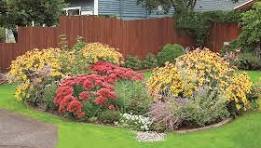Improve water quality in your community by planting a rain garden

This week we’ve been celebrating Earth Day and your kids have probably been talking to you about pollution, climate change, and the ways each of us can contribute to a healthier planet. Here’s a way that you may not have thought of before – create a rain garden for your home.
Strategically located, rain gardens are designed to capture runoff water from hard surfaces such as driveways, patios, sidewalks, or streets. After a storm or heavy rain, the rain garden will fill with a few inches of water that is then filtered into the surrounding soil. So instead of running into the street or storm culvert, the water can foster the growth of a beautiful garden. What’s more, a rain garden also improves the quality of the water we all use. Here’s why.

During a rainstorm, the water produced runs off artificial surfaces such as roofs and driveways collecting polluting particles of dirt, fertilizer, chemicals, oil, garbage, and bacteria. The water, now laden with pollutants, runs untreated into storm drains, flowing directly into nearby streams and ponds. In fact, according to the U.S. EPA, 70% of all polluted water is due to this rainwater runoff.
Collecting rainwater runoff in rain gardens allows the water to be filtered by vegetation before percolating back into the soil to recharge groundwater aquifers. During this process the pollutants are filtered out by the soil and plant roots.
How Does a Rain Garden Differ from a Flower Bed?
Rain gardens are usually built on a downward slope of a property so that the rain runoff from the lawn, roof, and the driveway of the home is directed toward the garden. Typically, six to twelve inches of soil is removed and mixed with tillage, compost, and sand to increase water infiltration. It usually takes up to 48 hours after a major rainfall to complete the infiltration process. Since the landscaping of most rain gardens incorporates native plants, no fertilizer is needed and maintenance is usually minimal after the first year.

What Plants Grow Best In a Rain Garden?
Try a mix of perennials, shrubs, wildflowers, grasses, and natives as well as other plants recommended for your USDA growing zone. Whatever you plant should be able to thrive when rainwater fills the garden and during dry conditions when rain is scarce.
Ideally, native vegetation should be part of your rain garden since native plants don’t require fertilizer, have good root systems, and utilize the water and nutrients available in their native soils better than non-native species. Shrubs and grasses as well as wildflowers like Black-eyed Susan, Butterfly Weed, Golden Alexander, Obedient Plant, Purple Coneflower, Spiderwort, Wild Columbine, and Wild Geranium are all good choices.

However, you should avoid planting trees in a rain garden since trees tend to absorb more water than surrounding plants. Also avoid planting invasive or noxious species such as purple loosestrife.
You can get more suggestions from your local nursery about plants that are suitable for a rain garden in your area or search the rain garden plant database.
How Much Space Does a Rain Garden Take?
To be effective, a rain garden should equal 20% of the roof, pavement, or patio area that’s draining into it. For a residential home, that’s equal to between 100 to 400 square feet. Generally, rain gardens are longer than they are wide and should be placed perpendicular to the land slope so they can catch as much of the rainfall as possible.

They should also be at least ten feet away from the foundation of any buildings and away from anywhere where water forms a puddle for an extended period of time.
What Kind of Maintenance Does a Rain Garden Require?
Surprisingly little! Rain gardens are very easy to maintain because when native plants are used, there’s no need for pesticides or fertilizer. During the first year or so, as the garden is becoming established or during times when there is little or no rain, watering is only required occasionally. You may also have to do some weeding and replace any plants that have died. But once the garden has taken hold, the plants will have had a chance to grow large enough to compete successfully with the weeds.

How Much Does It Cost to Install a Rain Garden?
The cost of installing a rain garden depends on the property’s soil type, the size of the area draining into the garden, and the types of plants you’re using. You may want to consider installing an under drain system if the soil has a high clay content. This will prevent water standing in the garden for more than 48 hours.
The cost for materials – plants and soil additions, especially soil with a high clay content – will be between $3 and $5 per square foot. If you work with a landscaper the cost is between $10 and $15 per square foot. While this cost is higher than a DIY project, a professional can also install an under drain system for you and advise you regarding any other issues you may encounter. Remember, a rain garden is a long-term project and will be relatively maintenance-free if it’s installed properly.

How Do Rain Gardens Benefit the Community?
Rain gardens not only beautify and improve the look of your own property, they benefit the whole community. By filtering pollutants from rainwater before it returns to streams and ponds, rain gardens create a cleaner water supply for all of us. They also provide stormwater and flood control for the local area. And planting native plants in these gardens helps preserve native vegetation and support the birds, butterflies, and insects these plants attract. Finally, these gardens fill our landscape with beauty without demanding more than minimal maintenance.
For more information on how to install a rain garden please call us at 847-912-6319.
It’s a wonderful way to beautify your property while making the water supply healthier for us all.




